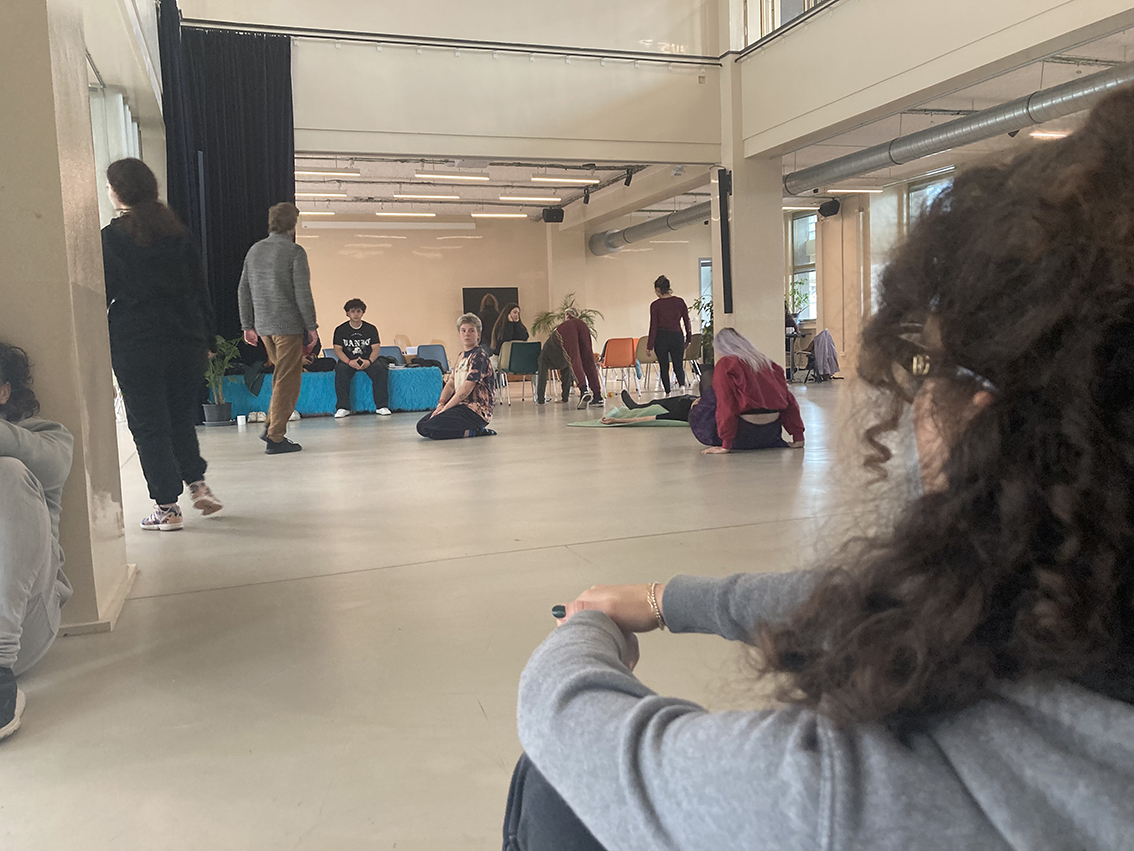Performative Demands
Download the methods
To download the methods, click here
Target group
No. of pax
Environment
Time needed
Materials
• Paper and pens
• Political demands from previous workshops, props that you worked with in other scenes (e.g. blankets, microphones etc.)
Objective/aim
The aim of this practice is to transform political demands into performative scenes that can be performed in small or big groups. We developed this approach because the participants had the strong wish to work with activist content in the performance for the MEPs in the Parliament. By using this method, we managed to have a strong intuitive and sensory approach, speaking to the viewer’s emotions as well as political content in the scenes.
All inputs came from the group, so the activity is participatory and makes all voices of the group heard. Furthermore, group structures and dynamics can be mixed up with this exercise.
Step by step instructions
Step 1
After revisiting the political demands, e.g. “reforestation strategies of the EU” the participants should take some time to think about one to three demands that resonate most with them. Walk with these demands in the room. Speak them aloud or in your mind, whisper them etc., while continuing to walk.
Step 2
To move from thinking into the performative body, we start warming up the voice and the body. Here you can use simple and the group’s favourite exercises. Also, concentrate on your position and presence in space.
Step 3
Then start to move in space and take positions: lying down, sitting, standing far away/close to each other etc. Concentrate on the distance and relationship to others in the space. Stay in a position for a while then change again. You can decide how much and fast/slow you want to change into different positions. Do this without speaking, for 10-15 minutes until you feel like everybody tried out different constellations and felt the connection of the bodies in space.
Step 4
Then form a circle. One person starts stepping into space stating their most important political demand and taking a position in space (like before). Once you take a position, you stay there until everybody has voiced their demand and found a position. If this demand or position resonates with you, you can also step into the space, say your demands and connect to the person – choose if you stand close to the person, sit next to them etc. One person after the other. Like this, every member of the group is stating their demand and relating to it in the space. Make a very clear picture for yourself: Who are you standing close/distant to? Which are connections that interest you? Remember them. When all stated their demand, form a circle again.
Step 5
Repeat Step 4 two to three times – maybe you want to change your statement or position; maybe the relations change because of the order.
Step 6
After the third round, see who are you standing in connection with. In this constellation start talking about your demands; maybe you want to invite other people to join you. Find your group, the number of participants is flexible. Take 30 minutes to work in this group transforming your demands into one scene. Start by deciding on one slogan and a group name; think of the scene like a pitch to your audience. Think about the form of the scene: it can be a show, a dance scene, participatory, an advertisement, a lecture etc. Work with all the performative knowledge and material that you have gained before. Artistic facilitators help the different groups if they need assistance. An example from our process: the demands related to reforestation/ or greener cities can be transformed into slogans like “Green Not Concrete”, the form of the scene was a TV advertisement for glasses. We encouraged the small group (that didn’t work together before) to let everybody speak, to find ideas together, trust their inputs and try out scenes.
Step 7
Present your scenes. Give feedback, maybe use the phrasing „what worked for me…“ Then continue working on the scenes as long as your time allows.
In the end the scene “green not concrete” turned out to be a very funny commercial – and the MEP in the Parliament got sunglasses made out of cardboard as a sample. The feedback was that the scene reflected critical methods of greenwashing and that laughter helped to connect to the theme in a different way.
Tips for the trainer
It’s recommended to do this activity close to the end of an artistic process, when the participants have performative tools at hand, know each other and already worked and are satisfied with their political demands.
Encourage the participants to raise their voice and stand behind their beliefs and demands. Remind them to feel the response of their demands through the movement of others and encourage the formation of other groups. Give them time to find their form of the scene, remind them of the performative tools they already have. It is good there are at least two facilitators present, to help them work in small groups.
Also encourage them to trust their bodies and voices in their expressions and the emotional level of their statements. Why is it important to you? What do you want to say about the demand? What connects you as a working group to focus on that demand?
Alternative
If you want to work more abstractly or with dance, the participants can also transform their statement into a short movement sequence; instead of saying it. Then furthermore concentrate on the intuitive connections of the movements, finding groups etc.
Comment
Source
Christina Rauchbauer was part of a „Wiener Perspective Meeting“ guided among others by Mariella Greil (Viennese performer) who introduced her to a similar approach.
The full approach of the “DasArts Feedback Method“ used for giving feedback like “What worked for me …” also mentioned here, you can find online:
https://www.atd.ahk.nl/en/theatre-programmes/das-theatre/study-programme/feedback-method-1/


